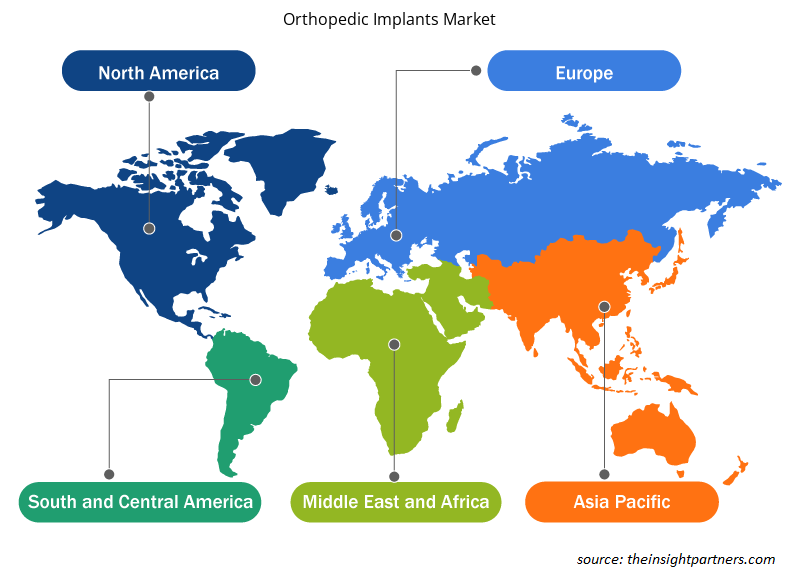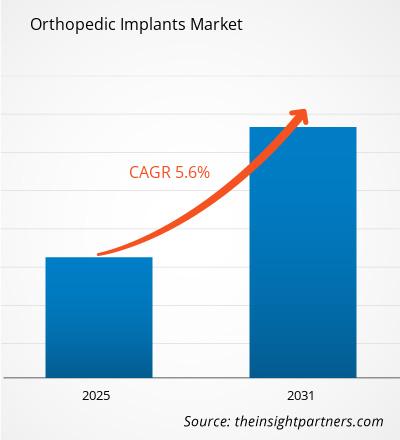Der Markt für orthopädische Implantate wird voraussichtlich von 2023 bis 2031 eine durchschnittliche jährliche Wachstumsrate (CAGR) von 5,6 % verzeichnen, wobei die Marktgröße von XX Millionen US-Dollar im Jahr 2023 auf XX Millionen US-Dollar im Jahr 2031 wachsen wird.
Der Bericht ist nach Produkt (Platten und Schrauben, Nägel und Stäbe, Stifte und Drähte, Sonstiges) segmentiert. Der Bericht enthält außerdem Analysen basierend auf der Anwendung (rekonstruktiver Gelenkersatz, Wirbelsäulenimplantate, Zahnimplantate, Traumaimplantate, Orthobiologie, Sonstiges). Darüber hinaus ist er basierend auf dem Endbenutzer (Krankenhäuser, orthopädische Kliniken, ambulante chirurgische Zentren, Sonstiges) segmentiert. Die globale Analyse ist weiter auf regionaler Ebene und nach wichtigen Ländern aufgeschlüsselt. Der Bericht bietet den Wert in USD für die oben genannte Analyse und die Segmente.
Zweck des Berichts
Der Bericht „Markt für orthopädische Implantate“ von The Insight Partners soll die aktuelle Situation und das zukünftige Wachstum sowie die wichtigsten treibenden Faktoren, Herausforderungen und Chancen beschreiben. Dies wird verschiedenen Geschäftspartnern Einblicke geben, wie zum Beispiel:
- Technologieanbieter/-hersteller: Um die sich entwickelnde Marktdynamik zu verstehen und die potenziellen Wachstumschancen zu kennen, damit sie fundierte strategische Entscheidungen treffen können.
- Investoren: Durchführung einer umfassenden Trendanalyse hinsichtlich der Marktwachstumsrate, der finanziellen Marktprognosen und der Chancen entlang der Wertschöpfungskette.
- Regulierungsbehörden: Sie regulieren Richtlinien und polizeiliche Maßnahmen auf dem Markt mit dem Ziel, Missbrauch zu minimieren, das Vertrauen der Anleger zu bewahren und die Integrität und Stabilität des Marktes aufrechtzuerhalten.
Orthopädische Implantate Marktsegmentierung
Produkt
- Platten & Schrauben
- Nägel & Stäbe
- Stifte und Drähte
- Sonstiges
Anwendung
- Rekonstruktiver Gelenkersatz
- Wirbelsäulenimplantate
- Zahnimplantate
- Trauma-Implantate
- Orthobiologie
- Sonstiges
Endbenutzer
- Krankenhäuser
- Orthopädische Kliniken
- Ambulante Chirurgische Zentren
- Sonstiges
Geographie
- Nordamerika
- Europa
- Asien-Pazifik
- Süd- und Mittelamerika
- Naher Osten und Afrika
Geographie
- Nordamerika
- Europa
- Asien-Pazifik
- Süd- und Mittelamerika
- Naher Osten und Afrika
Passen Sie diesen Bericht Ihren Anforderungen an
Sie erhalten kostenlos individuelle Anpassungen an jedem Bericht, einschließlich Teilen dieses Berichts oder einer Analyse auf Länderebene, eines Excel-Datenpakets sowie tolle Angebote und Rabatte für Start-ups und Universitäten.
-
Holen Sie sich die wichtigsten Markttrends aus diesem Bericht.Dieses KOSTENLOSE Beispiel umfasst eine Datenanalyse von Markttrends bis hin zu Schätzungen und Prognosen.
Wachstumstreiber auf dem Markt für orthopädische Implantate
- Zunehmende Alterung der Bevölkerung: Die weltweit steigende Zahl älterer Menschen führt zu einer höheren Prävalenz orthopädischer Erkrankungen, die Gelenkersatz und Wirbelsäulengeräte zur Verbesserung der Mobilität erfordern.
- Technologische Fortschritte: Innovationen bei Materialien und Fertigungsmethoden, wie etwa 3D-Druck und bioresorbierbare Implantate, verbessern die Gesamtleistung und Haltbarkeit orthopädischer Implantate erheblich und fördern so das Marktwachstum und bessere Behandlungsergebnisse für die Patienten.
- Zunahme von Sportverletzungen: Die zunehmende Teilnahme an Sport- und Fitnessaktivitäten hat die Häufigkeit von Sportverletzungen verändert, die orthopädische Implantate für eine angemessene Behandlung und Genesung erfordern. Daher wird die Marktexpansion vorangetrieben.
Markttrends für orthopädische Implantate
- Individuell angepasste Implantate: Die Kundenorientierung in Richtung individuell angepasster orthopädischer Implantate nimmt rasch zu. Diese bieten eine bessere Passform, mehr Komfort und eine bessere Leistung und führen so zu verbesserten Operationsergebnissen.
- Biologisch abbaubare Implantate: Biologisch absorbierbare orthopädische Implantate werden voraussichtlich die nachhaltige Option werden, die erneute chirurgische Eingriffe vermeidet; daher wird die zukünftige Marktnachfrage von einem umweltbewussten Verbraucherverhalten bestimmt.
- Roboterassistierte Chirurgie: Mit der Integration chirurgischer Techniken in die roboterassistierte Chirurgie beginnen sich orthopädische Verfahren im Hinblick auf eine präzise Platzierung von Implantaten und eine deutlich verkürzte Genesungszeit grundlegend zu verändern.
Marktchancen für orthopädische Implantate
- Steigende Gesundheitsausgaben: Erhöhte Gesundheitsausgaben weltweit, insbesondere in den Schwellenmärkten, werden den Menschen einen besseren Zugang zu fortschrittlichen orthopädischen Verfahren und Implantaten ermöglichen, was zu Marktwachstum und einer besseren Patientenversorgung führen wird.
- Fokus auf minimalinvasive Techniken: Die gestiegene Nachfrage nach minimalinvasiven chirurgischen Eingriffen bietet die Möglichkeit, innovative Implantate für solche Anwendungen zu entwickeln und so die Genesungszeiten zu verkürzen und die Kundenzufriedenheit zu steigern.
- Bildgebungstechnologien: Durch die Einführung moderner Bildgebungstechnologien wie MRT und CT können heute die präoperative Planung und anschließend die Gestaltung von Implantaten verbessert werden, um die Ergebnisse und Sicherheit chirurgischer Eingriffe bei orthopädischen Verfahren zu erhöhen.
Regionale Einblicke in den Markt für orthopädische Implantate
Die regionalen Trends und Faktoren, die den Markt für orthopädische Implantate im Prognosezeitraum beeinflussen, wurden von den Analysten von Insight Partners ausführlich erläutert. In diesem Abschnitt werden auch die Marktsegmente und die Geografie für orthopädische Implantate in Nordamerika, Europa, im asiatisch-pazifischen Raum, im Nahen Osten und Afrika sowie in Süd- und Mittelamerika erörtert.

- Erhalten Sie regionale Daten zum Markt für orthopädische Implantate
Umfang des Marktberichts zu orthopädischen Implantaten
| Berichtsattribut | Details |
|---|---|
| Marktgröße im Jahr 2023 | XX Millionen US-Dollar |
| Marktgröße bis 2031 | XX Millionen US-Dollar |
| Globale CAGR (2023 - 2031) | 5,6 % |
| Historische Daten | 2021-2022 |
| Prognosezeitraum | 2024–2031 |
| Abgedeckte Segmente |
Nach Produkt
|
| Abgedeckte Regionen und Länder |
Nordamerika
|
| Marktführer und wichtige Unternehmensprofile |
|
Marktdichte der Akteure auf dem Gebiet orthopädischer Implantate: Auswirkungen auf die Geschäftsdynamik verstehen
Der Markt für orthopädische Implantate wächst rasant, angetrieben durch die steigende Nachfrage der Endnutzer aufgrund von Faktoren wie sich entwickelnden Verbraucherpräferenzen, technologischen Fortschritten und einem größeren Bewusstsein für die Vorteile des Produkts. Mit steigender Nachfrage erweitern Unternehmen ihr Angebot, entwickeln Innovationen, um die Bedürfnisse der Verbraucher zu erfüllen, und nutzen neue Trends, was das Marktwachstum weiter ankurbelt.
Die Marktteilnehmerdichte bezieht sich auf die Verteilung der Firmen oder Unternehmen, die in einem bestimmten Markt oder einer bestimmten Branche tätig sind. Sie gibt an, wie viele Wettbewerber (Marktteilnehmer) in einem bestimmten Marktraum im Verhältnis zu seiner Größe oder seinem gesamten Marktwert präsent sind.
Die wichtigsten auf dem Markt für orthopädische Implantate tätigen Unternehmen sind:
- Smith und Nephew Plc.
- Zimmer Biomet Holdings, Inc.
- Stryker Corporation
- Johnson und Johnson (DePuy Synthes)
- Medtronic
Haftungsausschluss : Die oben aufgeführten Unternehmen sind nicht in einer bestimmten Reihenfolge aufgeführt.

- Überblick über die wichtigsten Akteure auf dem Markt für orthopädische Implantate
Wichtige Verkaufsargumente
- Umfassende Abdeckung: Der Bericht deckt die Analyse der Produkte, Dienstleistungen, Typen und Endbenutzer des Marktes für orthopädische Implantate umfassend ab und bietet einen ganzheitlichen Überblick.
- Expertenanalyse: Der Bericht basiert auf dem umfassenden Verständnis von Branchenexperten und Analysten.
- Aktuelle Informationen: Der Bericht stellt durch die Abdeckung aktueller Informationen und Datentrends Geschäftsrelevanz sicher.
- Anpassungsoptionen: Dieser Bericht kann angepasst werden, um spezifische Kundenanforderungen zu erfüllen und die Geschäftsstrategien optimal anzupassen.
Der Forschungsbericht zum Markt für orthopädische Implantate kann daher dabei helfen, die Branchensituation und Wachstumsaussichten zu entschlüsseln und zu verstehen. Obwohl es einige berechtigte Bedenken geben kann, überwiegen die allgemeinen Vorteile dieses Berichts tendenziell die Nachteile.
- Historische Analyse (2 Jahre), Basisjahr, Prognose (7 Jahre) mit CAGR
- PEST- und SWOT-Analyse
- Marktgröße Wert/Volumen – Global, Regional, Land
- Branchen- und Wettbewerbslandschaft
- Excel-Datensatz
Aktuelle Berichte
Verwandte Berichte
Erfahrungsberichte
Grund zum Kauf
- Fundierte Entscheidungsfindung
- Marktdynamik verstehen
- Wettbewerbsanalyse
- Kundeneinblicke
- Marktprognosen
- Risikominimierung
- Strategische Planung
- Investitionsbegründung
- Identifizierung neuer Märkte
- Verbesserung von Marketingstrategien
- Steigerung der Betriebseffizienz
- Anpassung an regulatorische Trends























 Kostenlose Probe anfordern für - Markt für orthopädische Implantate
Kostenlose Probe anfordern für - Markt für orthopädische Implantate